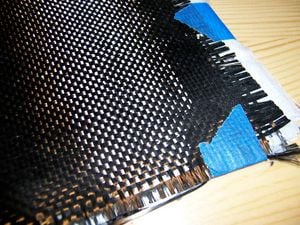B.S.Kukreja (talk | contribs) No edit summary |
B.S.Kukreja (talk | contribs) No edit summary |
||
| Line 17: | Line 17: | ||
==Aviation and Composites== | ==Aviation and Composites== | ||
Composite materials are important to the Aviation Industry because they provide structural strength comparable to metallic alloys, but at a lighter weight. This leads to improved fuel efficiency and performance from an aircraft. <ref name="A">INI International - Key to Metals - Retrieved at http://www.keytometals.com/Article103.htm </ref> | Composite materials are important to the Aviation Industry because they provide structural strength comparable to metallic alloys, but at a lighter weight. This leads to improved fuel efficiency and performance from an aircraft. <ref name="A">INI International - Key to Metals - Retrieved at http://www.keytometals.com/Article103.htm </ref><ref name="E">Boeing's 787 Dreamliner Has a Composite Problem - Zimbio - Retrieved at http://www.zimbio.com/Boeing+787+Dreamliner/articles/18/Boeing+787+Dreamliner+composite+problem</ref> | ||
[http://en.wikipedia.org/wiki/Boeing Boeing]'s [http://en.wikipedia.org/wiki/Boeing_787 787 Dreamliner] will be the first commercial aircraft in which major structural elements are made of composite materials rather than aluminum alloys.<ref name="F">Surface Modelling for Composite Materials - SIAG GD - Retrieved at http://www.ifi.uio.no/siag/problems/grandine/</ref> | |||
Revision as of 01:50, 4 December 2009
Template:MECH370 This page is still under construction.
Come back within the next few days for the completed piece!
Introduction
Composite materials are widely used in the Aircraft Industry to create hybrid materials that together fulfil a purpose that would otherwise not be possible if the materials were to be used separately. The development of light-weight, high-temperature resistant composite materials will allow the next generation of high-performance, economical aircraft designs to materialize. Development of such materials will reduce fuel consumption, improve efficiency and reduce direct operating costs of aircraft.
Synthesis of Basic Composites

In a basic composite, one material acts as a supporting matrix, while another material builds on this base scaffolding and reinforces the entire material. An example of such a material is a Fibre-reinforced plastic, which consists of numerous glass fibres embedded in a resin or epoxy matrix.
Formation of a composite material can be an expensive and complex process. In essence, a base composite material is laid out in a mould under high temperature and pressure. An epoxy or resin matrix is then poured over the base composite material, creating a strong material when heat is removed and solidification occurs.
Aviation and Composites
Composite materials are important to the Aviation Industry because they provide structural strength comparable to metallic alloys, but at a lighter weight. This leads to improved fuel efficiency and performance from an aircraft. [1][2]
Boeing's 787 Dreamliner will be the first commercial aircraft in which major structural elements are made of composite materials rather than aluminum alloys.[3]
Energy Savings
Environmental Impact
Future Composite Materials
- Ceramic Matrix Composites
Major efforts are underway to develop light-weight, high-temperature composite materials at National Aeronautics and Space Administration (NASA) for use in aircraft parts. Temperatures as high as 1650°C are anticipated for the turbine inlets of a conceptual engine based on preliminary calculations.[1] In order for materials to withstand such temperatures, the use of Ceramic Matrix Composites (CMCs) is required. The use of CMCs in advanced engines will also allow an increase in the temperature at which the engine can be operated, leading to increased yield. [4] Although CMCs are promising structural materials, their applications are limited due to lack of suitable reinforcement materials, processing difficulties, lifetime and cost.
- Spider Silk Fibres
Spider silk is another promising material for composite material usage. Spider silk exhibits high ductility, allowing stretching of a fibre up to 140% of its normal length. Spider silk also holds its strength at temperatures as low as -40°C.[5] These properties make spider silk ideal for use as a fibre material in the production of ductile composite materials that will retain their strength even at abnormal temperatures. Ductile composite materials will be beneficial to an aircraft in parts that will be subject to variable stresses, such as the joining of a wing with the main fuselage. The increased strength, toughness and ductility of such a composite will allow greater stresses to be applied to the part or joining before catastrophic failure occurs. Many unsuccessful attempts have been made at reproducing spider silk in a laboratory, but perfect re-synthesis has not yet been achieved. [6]
References
- ↑ 1.0 1.1 INI International - Key to Metals - Retrieved at http://www.keytometals.com/Article103.htm
- ↑ Boeing's 787 Dreamliner Has a Composite Problem - Zimbio - Retrieved at http://www.zimbio.com/Boeing+787+Dreamliner/articles/18/Boeing+787+Dreamliner+composite+problem
- ↑ Surface Modelling for Composite Materials - SIAG GD - Retrieved at http://www.ifi.uio.no/siag/problems/grandine/
- ↑ R. Naslain - Universite Bordeaux - Ceramic Matrix Composites - Retrieved at http://www.mpg.de/pdf/europeanWhiteBook/wb_materials_213_216.pdf
- ↑ Department of Chemistry - University of Bristol - Retrieved at http://www.chm.bris.ac.uk/motm/spider/page2.htm
- ↑ Wired Science - Spiders Make Golden Silk - Retrieved at http://www.wired.com/wiredscience/2009/09/spider-silk/